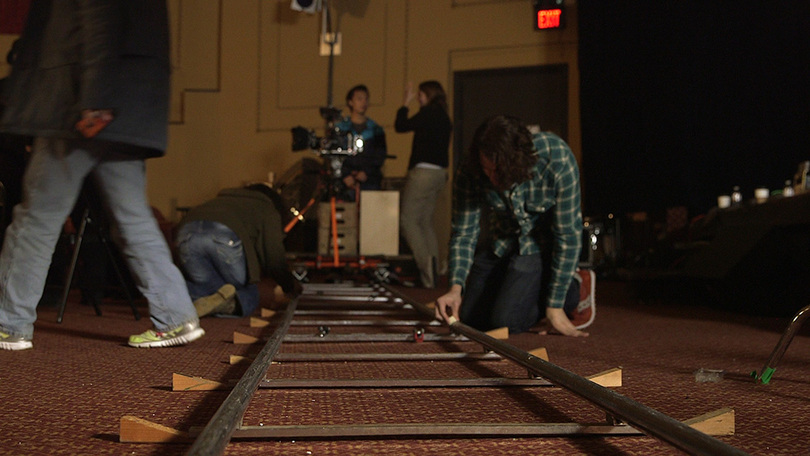SU students and professor try to raise $30,000 to fund independent movie

The film "39 1/2" will be directed by professor Kara Herold, whose previous film “Grrlyshow” premiered at the Sundance Film Festival in 2001. Photo Courtesy of Kara Herold
UPDATED: Feb. 18, 2016 at 5:01 p.m.
A group of students and a professor huddle around a table in Shaffer Art Building, laughing.
“Let’s do a people auction,” one girl said. “Like auction off people for dates.”
“Wait no, let’s auction off roles in the film,” another one joked.
They continued to brainstorm goofy ways to raise $30,000.
The making of an independent feature film isn’t cheap. Syracuse University film professor Kara Herold needs $60,000 to finish shooting her film, $30,000 of which she’s fairly certain she has covered. She and her students are raising the money through her Kickstarter account and by applying for grants.
Many of these expenses are for transportation, housing and food for her crew — the students of her selected topics class, FIL 500: “On-Set Film Production.”
The class was started last semester for students to gain experience working on a real movie set. Come Spring Break, students will be working on the set of Herold’s film, “39 1/2.”
But this semester, the movie is facing budget cuts and has undergone major changes in structure, location and the cost of operation to compensate.
“39 1/2” combines narrative drama and comedy genres in telling the story of Kara, a filmmaker going on 40 years old who is desperate to have a child. The semi-autobiographical movie follows the twists of fate she encounters throughout her mid-life crisis-like journey. It’s influenced by films such as “Bridesmaids,” “Mistress America” and “Raising Arizona.” Herold has been working on the film for a couple years, setting her shooting deadline for June.
Her ultimate goal for the class and film is for “39 1/2 “ to premier at Sundance Film Festival — where her film “Grrlyshow” premiered in 2001 — and to bring her students with her.
Each student in the class is assigned a specific department and/or role for the duration of the class: lighting department, grip and electrical departments, art department and production. Under Herold’s direction, the production department includes assistant directors, producers and production assistants.
During a typical day of shooting, as a second assistant director last semester, junior film major Eryn Pendergast had a seemingly never-ending list of tasks to prioritize.
She woke up at 6 a.m., helped load a U-Haul with film equipment, drove to the set location, put together a refreshments table, organized the set with all the odds and ends, such as a first aid kit, signed in the actors, kept all the members of the cast and crew on schedule and did favors a mile a minute wherever and whenever she was needed. After an eight to 10 hour work day of scrambling, usually on a Saturday or Sunday, she finally hit the road.
It’s stuff you can’t learn in a classroom that’s so valuable as a filmmaker.Eryn Pendergast
“(Herold) really took me under her wing, and this is something I really would like to do after school ends. It’s cool that she saw that in me and was really able to teach me,” Pendergast said.
Herold holds her students to the standard of a professional crew.
“I’m really putting a lot of responsibility on the students, like this is your job, you learn it,” she said. “And then if they show up and they don’t know how to do it, it’s kind of like, if you were on the set, you’d be fired.”
Pendergast and junior film major JJ House, a former advertising representative for The Daily Orange, are preparing for their responsibility as this semester’s co-assistant directors by doing preproduction work with Herold during her other class, FIL 500: “Business of Art Filmmaking,” applying for grants to fund the class and scouting out green rooms and shooting locations in New York City.
House described the role of assistant director as “the engine of the set.”
The necessity to be resourceful as a film student is taken to a new level with this class.JJ House
This class isn’t the first opportunity VPA students have had to work on their professor’s sets. Before the class existed, Herold and other professors directing their own films would often unofficially ask a few students to help them out. The class was created as a way to continue doing that while giving students proper credit and letting them participate on a larger scale.
Herold decided the trial run of the course was a success. The students walked out with applicable real-world experience, she said, and she was able to shoot part of the footage for her film.
That’s not to say there weren’t bumps in the road. Herold and Pendergast laughed as they recounted being confronted by the police after filming in a church because they were mistaken for burglars.
The class has seen several major changes this semester. First, the class will go to New York City for 10 days during spring break with the students working 12- to 16-hour work days.
This change happened because last semester, Herold needed too much equipment for student projects. Also, the longer work days in a more concentrated time frame is a more accurate experience to the schedule of working on a real set for a feature film, she said.
The next major change was the size of the class. The class shrunk from 24 students last semester to 12 this semester. To choose which few students got to enroll, Herold sent out an application. To further narrow down candidates, she also judged their academic performance and talked to their professors. She ended up having to turn away more than 20 students from the class.
Ideally, in future semesters, Herold said she hopes the class can be available to all students who would benefit from the experience.





